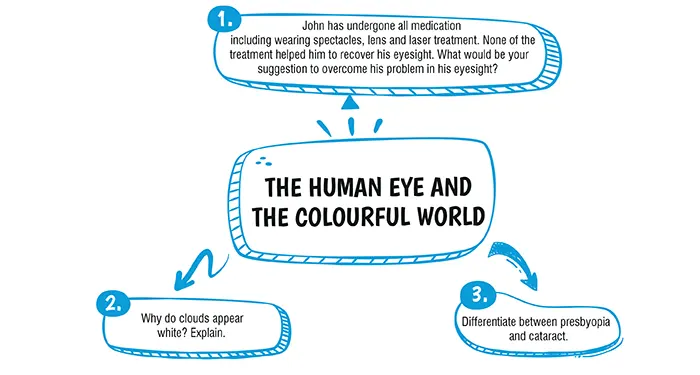Table of Contents

Ans. (b)
Explanation:
When a ray of light passes through a prism and undergoes refraction, the emergent ray takes a different path compared to the incident ray. The emergent ray bends at an angle to the direction of the incident ray.
Ans. (a)
Explanation:
At noon because the sun is overhead, the light is scattered the least and hence appears white. When it is overhead, it has lesser air to travel through and the scattering from dust and other particles is reduced if the distance to be travelled in air is reduced.
Explanation:
Though all the treatment for recovering from his eye problems did not help him out, I would suggest him to opt for eye transplantation which would get his eyesight back to normal. In transplantation of eye, the entire diseased eye cannot be replaced. Only the diseased cornea can be replaced by the donated cornea.
Explanation:
The clouds contain dust particles and water molecules of size bigger than the wavelength of visible light, so they scatter all colours of incident white light from sun to the same extent and hence when the scattered light reaches our eyes, the clouds are seen white.
Explanation:
| S no. | Presbyopia | Cataract |
|---|---|---|
| 1. | It is a defect of vision due to which an old person cannot see the nearby objects clearly due to loss of power of accommodation of eye. | It is the medical condition in which the lens of the eye of a person becomes progressively cloudy resulting in blurred vision. |
| 2. | It can be corrected by using spectacles having bifocal lens of suitable power. | It cannot be corrected by any type of spectacle lenses. |
| 3. | Surgical operations is not required to rectify Presbyopia. | The vision of a person can be restored by getting surgery done on the eye having cataract. |
| Chapter No. | Chapter Name |
|---|---|
| Chapter 1 | Chemical Reactions and Equations |
| Chapter 2 | Acid, Bases and Salts |
| Chapter 3 | Metals and Non-Metals |
| Chapter 4 | Carbon and its Compounds |
| Chapter 5 | Life Processes |
| Chapter 6 | Control and Coordination |
| Chapter 7 | How do Organisms Reproduce |
| Chapter 8 | Heredity |
| Chapter 9 | Light : Reflection and Refraction |
| Chapter 10 | The Human Eye and the Colourful world |
| Chapter 11 | Electricity |
| Chapter 12 | Magnetic Effects of Electric Current |
| Chapter 13 | Our Environment |
| Chapter Wise Important Questions for CBSE Board Class 10 Science |
|---|
| Chemical Reactions and Equations |
| Acid, Bases and Salts |
| Metals and Non-Metals |
| Carbon and its Compounds |
| Life Processes |
| Control and Coordination |
| How do Organisms Reproduce |
| Heredity |
| Light : Reflection and Refraction |
| The Human Eye and the Colourful world |
| Electricity |
| Magnetic Effects of Electric Current |
| Our Environment |
CBSE Important Questions Class 10
ICSE Important Questions Class 10
CBSE Important Questions Class 10
ICSE Important Questions Class 10